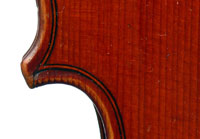|
Ref : 0869
A good French violin from the firm of
|

go to Home Page see more Violins |
As much as he was highly noted among French violin makers, Léon Bernardel (1853 - 1931) was also very business-minded. Apart from heading the sizeable Bernadel violin empire, based in Paris, he became one of the directors in 1914 of Couesnon & Co., a large firm dealing in high-end musical instruments. The English authority, William Henley, refers to this firm as 'large exporters of musical merchandise.' These instruments, which were destined for foreign markets, were almost exclusively French trade items sourced variously from studios in Mirecourt and elsewhere.This violin is undated and has two labels in it - one slightly over the other (see photo). The upper label states that the violin was made under the supervision of Léon Bernardel and the lower label states the name COUESNON Luthier, followed by an address. Both are euphemistically ambiguous, creating the impression that Bernardel stood by, watching the instrument being made, and attributing to Couesnon the status of violin maker. This did not entirely reflect how it was done. For one thing, legally, if the making of the violin met with standards laid down by Bernardel (even if he lived in another city) it could be said that it was made under his direction (as stated in the label). Furthermore, there existed no physical person Couesnon who was ever listed as a violin maker in any important reference source. It was merely an adaptation of the name of the firm Bernardel was director of.
In dealing with this instrument two things must be understood: firstly, Bernardel did not make this violin, although he did lay down minimum requirements for it. Secondly, there was no violin maker by the name of Couesnon - it remains a generic name derived from the name of the exporting firm.
So, what is the actual origin of the violin? It would have been made in the period after Bernardel became director in Couesnon & Co., probably around 1915. It clearly is French in workmanship and varnish and it can be said with confidence that it is a high-end instrument from a Mirecourt studio similar to that which also supplied to Jérôme Thibouville-Lamy (JTL) and other large French business. Such instruments targeted the foreign markets of England and the USA, and elsewhere.
Today these instruments are greatly respected and (along with similar German counterparts) are referred to as Good French Trade, which has its own price history and pricing bracket.
This violin is of good materials - the two-piece back is of nicely figured maple of a narrow curl sloping downward from the centre line to the flanks. The same wood is used for the ribs, but the neck and scroll are of less figured wood. The top is of spruce of a somewhat open grain. The spirit-based varnish is reddish-brown over a golden ground and contrived to give the appearance of wear, particularly in the back, but all such 'wear' is deliberately and artificially induced. The arching is quite flat, contributing to a nice strong tone. Except for a repaired minor wing crack, there is no sign of repairs of cracks anywhere in the violin and it can be said to be in excellent condition.
It is well-toned.
 |
 |
 |
||
 |
Dimensions : Length of back: 35.7 cm
Condition : Excellent condition. A minor wing crack to the treble F-hole has been repaired. No other cracks or evident repairs anywhere. Some 'wear' artificially induced, particularly in the back, to give the impression of age.
Furthermore, all the pegholes have been rebushed. This was probably undertaken by Dawne Haddad, a Cremonese-trained luthier, who also did the bridge. The setup is by Johan Grobbelaar.
Provenance : Withheld
Price : P.O.A.
 |
 |
 |
 |
 |
 |
 |
 |
 |
 |
 |
 |
|||||
 |
 |
 |